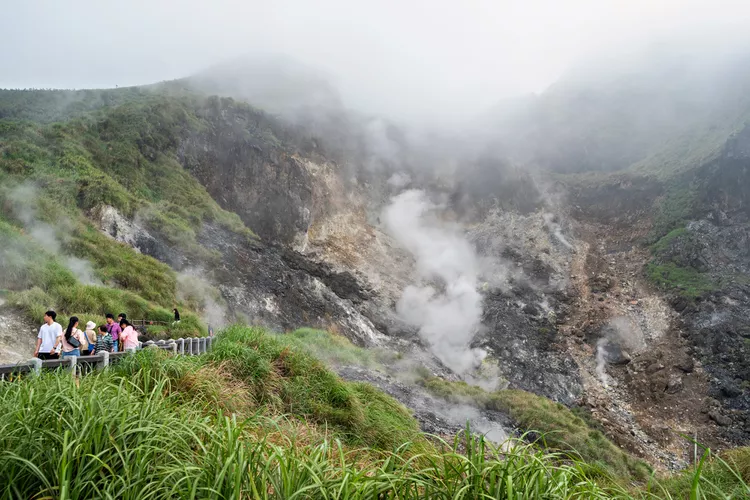Summary
Discovering Taiwan’s Majestic Landscape
Beyond the city limits of ultramodern Taipei lies a wild and majestic landscape. This guide will help you plan an adventurous trip through Taiwan, known for its breathtaking mountains, lush forests, and rich cultural heritage.
As I climbed what felt like my millionth flight of stairs toward the peak of Qixing Mountain in Taiwan’s Yangmingshan National Park, I was reminded that mountains can be relative. I had climbed many peaks in my home state of Colorado, but had never felt as intimidated as I did by this 3,675-footer. This dormant volcano seemed to rise straight up from sea level, stretching toward the stars—Qixing means “Seven Stars,” the Chinese name for the Big Dipper.
On our hike, thickets of tall tufted grass were home to bright birds and the occasional Taiwan partridge, known as a “bumble chicken.” We had passed through diverse landscapes featuring billowing fumaroles emitting sulphurous steam and serene lily ponds filled with the chorus of frogs. Yet the sheer verticality of our surroundings surprised us; the stone steps appeared to ascend directly into the clouds.

Taiwan, an island comparable in size to the Netherlands but with a population similar to that of Australia, is often overshadowed by its modern exports like bubble tea and high-tech products. Despite this, Taiwan’s natural settings boast an array of habitats—from chilly mountain tops to flourishing subtropical forests—accessible via high-speed rail or short flights.
Exploring Taipei’s Urban Charm
My visits to Taipei had primarily involved urban delights—indulging in local cuisines at night markets and exploring vibrant shops. However, this time, I discovered the natural beauty that lies just outside the city limits. The island is home to a variety of habitats, and participating in outdoor adventures like hiking Jade Mountain and swimming in Sun Moon Lake is often considered essential to truly experiencing Taiwanese culture.
Taiwan is characterized by its steep and dramatic mountainous terrain shaped by active geological processes. Our guide, Vincent Hsu, highlighted that the land was formed just 4 to 5 million years ago from volcanic activity at the intersection of two tectonic plates, leading to an abundance of hot springs, stunning ridges, and a thick green vegetation populated with unique flora and fauna.

Adventurous Escapades in Nature
The breathtaking views from the summit rewarded our rigorous climb with a glimpse of the Tamsui River glistening as it winds through Taipei. The “cloud sea” effect created a beautifully minimalist landscape resembling an ink painting.
Even within the heart of Taipei, there is an abundance of green spaces. The city, populated with 2.6 million residents, effortlessly blends urban dynamics with tranquility. Walking through artisanal teahouses and quaint gardens, I felt a deep connection to the natural surroundings, even amid the bustle of city life.

Delighting in Taiwanese Cuisine
Outdoor dining appears to be a national pastime in Taiwan. On the day following our hike, we ventured to Jiufen, known for its stunning views and culinary delights. We indulged in sweet taro and mung bean soup, freshly made “wheelcakes,” and creative rice-paper burritos filled with taro ice cream and crushed peanut brittle—a combination that surprised and delighted us.
As we continued our culinary exploration, we stopped to try ripe strawberries wrapped in red bean paste and fresh mochi from street vendors. Our evening led us to the tranquil banks of the Tamsui River, where we relished local snacks while watching the beautiful Taiwan blue magpies flit through the trees.

Cultural Insights and Historical Context
As we explored, Hsu shared insights regarding Taipei 101, a tower that epitomizes the city’s skyline. Our lunch at Din Tai Fung restaurant introduced us to a world-famous delicacy of soup dumplings, each artistic fold exquisite and inviting.
Taiwan’s history is marked by various cultures and colonization, which has created a vibrant and multifaceted society. The island is currently navigating its identity in the context of global politics while cherishing its rich traditions and diversity.

As we traversed the Central Cross-Island Highway, once an imposing project of Japanese imperialism, I marveled at the beauty surrounding us and the history embedded within the landscape. Taroko National Park offers a glimpse into this rich tapestry, showcasing the natural beauty that fuels the Taiwanese spirit.
In conclusion, Taiwan, known for its spectacular scenery and vibrant culture, invites travelers to engage with its natural wonders and explore the incredible array of experiences it offers. Whether you seek hiking, cultural insights, or culinary delights, this island has it all—making it a remarkable destination for any adventurous traveler.
How to Plan a Taiwan Trip
Taipei
Gaia Hotel: A contemporary hotel with in-room mineral baths drawn from sulphurous hot springs.
Mandarin Oriental, Taipei: This grand hotel in the financial district has impeccable service and a lavish breakfast buffet.
Din Tai Fung: Famed for its delectable soup dumplings filled with rich pork broth.
National Palace Museum: Offers one of the world’s most significant collections of Chinese art and artifacts.
Taipei 101: This iconic skyscraper features observation decks with sweeping views of the city.
Taroko
Liiko Hotel: A boutique hotel near Taroko National Park offering remarkable views of cliffs.
Long Gone Café: An artsy spot known for its delicious tea pudding.
Hengchun Peninsula
Gloria Manor: A refined hotel within Kenting forest, ideal for relaxation and exploration.
Ko Brunch: Serves traditional breakfasts and local specialties.
Wild Kids Bar: A relaxed beachside venue for enjoying local beer and barbecue.





